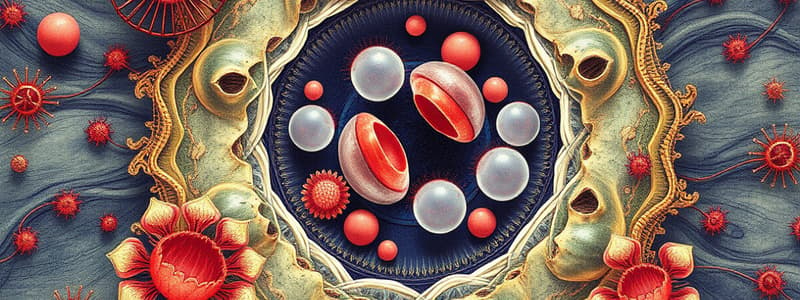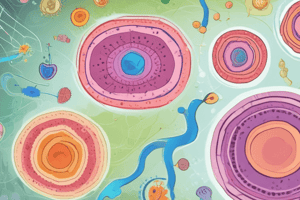Podcast
Questions and Answers
What is the primary function of mitochondria in a cell?
What is the primary function of mitochondria in a cell?
- Storage of genetic material
- Photosynthesis
- Energy production (correct)
- Protein synthesis
Which organelle is primarily involved in modifying and packaging proteins for secretion?
Which organelle is primarily involved in modifying and packaging proteins for secretion?
- Nucleus
- Lysosome
- Golgi Apparatus (correct)
- Endoplasmic Reticulum
During which phase of mitosis do chromosomes align at the cell's equatorial plane?
During which phase of mitosis do chromosomes align at the cell's equatorial plane?
- Telophase
- Anaphase
- Metaphase (correct)
- Prophase
What type of transport requires energy to move substances against their concentration gradient?
What type of transport requires energy to move substances against their concentration gradient?
Which of the following best describes cellular respiration?
Which of the following best describes cellular respiration?
Which structure is responsible for synthesizing proteins in the cell?
Which structure is responsible for synthesizing proteins in the cell?
What process allows a cell to engulf material from outside?
What process allows a cell to engulf material from outside?
Which of the following statements about the nucleus is true?
Which of the following statements about the nucleus is true?
Flashcards are hidden until you start studying
Study Notes
Cell Biology Study Notes
Basic Cell Structure
-
Cell Membrane:
- Semi-permeable barrier.
- Composed of a phospholipid bilayer with embedded proteins.
-
Cytoplasm:
- Gel-like substance where cellular processes occur.
- Contains organelles and cytosol.
-
Nucleus:
- Control center containing genetic material (DNA).
- Surrounded by the nuclear envelope.
Organelles
-
Mitochondria:
- Powerhouse of the cell; site of ATP (energy) production.
- Contains its own DNA.
-
Ribosomes:
- Protein synthesis machinery.
- Can be free-floating in cytoplasm or attached to the endoplasmic reticulum.
-
Endoplasmic Reticulum (ER):
- Rough ER: Studded with ribosomes; synthesizes proteins.
- Smooth ER: Lacks ribosomes; synthesizes lipids and detoxifies.
-
Golgi Apparatus:
- Modifies, sorts, and packages proteins and lipids for secretion or use within the cell.
-
Lysosomes:
- Contains digestive enzymes.
- Breaks down waste materials and cellular debris.
-
Centrioles:
- Involved in cell division; helps organize the mitotic spindle.
-
Chloroplasts (in plant cells):
- Site of photosynthesis; converts solar energy into chemical energy (glucose).
Cell Division
-
Mitosis:
- Somatic cell division resulting in two identical daughter cells.
- Phases: Prophase, Metaphase, Anaphase, Telophase, and Cytokinesis.
-
Meiosis:
- Reduction division producing gametes (sperm and egg).
- Consists of two rounds of division (Meiosis I and II).
Cellular Processes
-
Cellular Respiration:
- Process of converting glucose and oxygen into energy (ATP), carbon dioxide, and water.
- Stages: Glycolysis, Krebs Cycle, Electron Transport Chain.
-
Photosynthesis (in plants):
- Conversion of light energy into chemical energy (glucose).
- Occurs in chloroplasts; involves light-dependent and light-independent reactions.
-
Protein Synthesis:
- Transcription (DNA to mRNA) in the nucleus.
- Translation (mRNA to protein) at ribosomes.
Membrane Transport
-
Passive Transport:
- Movement of molecules without energy (e.g., diffusion, osmosis).
-
Active Transport:
- Movement of molecules against their concentration gradient using energy (ATP).
-
Endocytosis and Exocytosis:
- Endocytosis: Cell engulfs material from outside.
- Exocytosis: Cell expels material to the outside.
Cell Signaling
-
Signal Transduction:
- Process by which a cell responds to external signals (e.g., hormones).
-
Receptors:
- Proteins that receive signaling molecules and initiate cellular responses.
Cell Theory
- All living organisms are composed of cells.
- The cell is the basic unit of life.
- All cells arise from pre-existing cells.
Basic Cell Structure
- Cell Membrane:
- Semi-permeable barrier made of a phospholipid bilayer with proteins that regulate passage of substances.
- Cytoplasm:
- Gel-like substance where organelles are suspended and cellular processes occur.
- Nucleus:
- Control center of the cell containing DNA, enclosed by a nuclear envelope.
Organelles
- Mitochondria:
- Known as the cell's powerhouse; responsible for ATP production and contains its own DNA.
- Ribosomes:
- Sites of protein synthesis; may exist freely in the cytoplasm or bound to the endoplasmic reticulum.
- Endoplasmic Reticulum (ER):
- Rough ER: Contains ribosomes for protein synthesis.
- Smooth ER: Lacks ribosomes, involved in lipid synthesis and detoxification processes.
- Golgi Apparatus:
- Modifies, sorts, and packages proteins and lipids for secretion or use within the cell.
- Lysosomes:
- Organelles filled with digestive enzymes that break down waste materials and cellular debris.
- Centrioles:
- Cylinder-shaped structures essential for organizing the mitotic spindle during cell division.
- Chloroplasts (found in plant cells):
- Sites of photosynthesis that convert solar energy into glucose.
Cell Division
- Mitosis:
- Type of somatic cell division that results in two genetically identical daughter cells; consists of Prophase, Metaphase, Anaphase, Telophase, and Cytokinesis.
- Meiosis:
- Specialized cell division for gametes that involves two rounds of division (Meiosis I and II) resulting in four non-identical cells.
Cellular Processes
- Cellular Respiration:
- Converts glucose and oxygen into ATP, carbon dioxide, and water; involves Glycolysis, Krebs Cycle, and Electron Transport Chain.
- Photosynthesis:
- Occurs in chloroplasts, transforming light energy into glucose via light-dependent and light-independent reactions.
- Protein Synthesis:
- Involves Transcription (DNA to mRNA) in the nucleus and Translation (mRNA to protein) at ribosomes.
Membrane Transport
- Passive Transport:
- Molecules move across membranes without energy expenditure (includes diffusion and osmosis).
- Active Transport:
- Energy-dependent movement of molecules against concentration gradients, utilizing ATP.
- Endocytosis and Exocytosis:
- Endocytosis: Cell actively engulfs external material.
- Exocytosis: Cell expels internal materials to the external environment.
Cell Signaling
- Signal Transduction:
- Mechanism by which cells respond to external signals such as hormones to elicit a response.
- Receptors:
- Protein molecules that bind to signaling molecules, triggering cellular responses.
Cell Theory
- All living organisms are composed of cells, which are the basic units of life.
- Cells arise only from pre-existing cells, reinforcing the continuity of life.
Studying That Suits You
Use AI to generate personalized quizzes and flashcards to suit your learning preferences.




